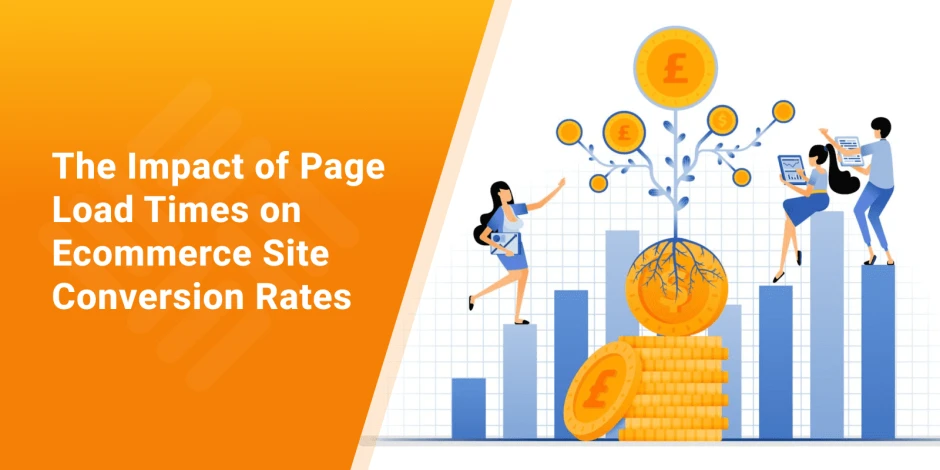How Ecommerce Site Speed Drives Conversions
-
 Anton Gurtovoi
Anton Gurtovoi
- Magento 2
- 7 min read
Page load time impact on conversion rate can be crucial to the website's success. The page load speed is a metric that tells how long the user must wait before interacting with a web page. This broad term encapsulated several statistics. It can represent the speed of loading content or active elements, such as shopping carts or item constructors. Most often, it is measured in seconds or milliseconds.
Some may think a 1 or 2-second delay before the user sees the page isn't worth noticing. Especially so with modern internet speed. However, a study conducted by Portent in 2022 begs to differ. Results say: a website that loads within 1 second is three times more popular than those with a 5-second loading. The pages that take 10 or more seconds to load have five times fewer conversions than their faster counterparts.
Google uses special algorithms to rate web pages based on their comfort for users. They are called Web Vitals. Different loading speeds are a vital part of those statistics. There are five metrics related to the loading speed:
- LCP or Largest Contentful Paint. It counts the time from when a user enters the website to when the largest element on the page is loaded.
- FID or First Input Delay. Tracks how long it takes to send a response to the user’s first interaction in milliseconds.
- FCP or First Contentful Paint. Like the LCP, but this metric counts the time before any data from the page is loaded.
- SI or Speed Index. Represents how fast the content visibly appears on the page while it is loading.
- TTI or Time to Interactive. Counts the time from the start of the loading to the fully loaded intractable page.
These statistics impact how Google and other search engines see your website. A well-organized page with relevant content can still end up at the tail of the first page of search results because of its loading speed.
Page speed conversion rate statistics
The Conductor has compiled a case study of several big sites’ experiences with page speed and conversion rate. Research showed that speed optimization always had an impact on the conversion rate.
In 2021, Vodafone reported increased revenue due to improvements in Web Vitals. To be more precise, they optimized the loading speed of the largest elements on their landing page. Tests showed that sales increased by 8% in comparison to unoptimized pages. In the same year, Yelp shared about increased conversion rates by 15%. This time, page optimization touched on the load speed of the first content shown and the fully loaded interactive page. Mainly, those results were achieved by lightening the structure of the website.
Pfizer discovered that by 2019, 15 of their websites had slow load speeds, sometimes reaching more than 20 seconds. The company optimized its web pages, and results showed a 20% decrease in the bounce rate. In 2020, Propellernet found out that, on average, users are 34% more likely to interact with a quick-loading page. The study was conducted both for desktop and mobile users.
Mobile Horizons
Computer users usually have high-speed internet connections. However, people with mobile devices often use mobile internet. Despite recent improvements in the speed of this connection, it is still lacking compared to broadband. This means page speed impact on conversion rate becomes much more noticeable. Google says the average website loads in 15 seconds on mobile devices. The same statistics but for desktop users show approximately 5 seconds to load. Almost three times the difference.
Generally, mobile devices struggle with these elements:
- Images. High-resolution pictures, especially JPEG and GIF format, can often be the slowest to load on a page.
- Embedded videos. The 720p quality video can significantly slow down the load speed for 3G and noticeably lower it for 4G users.
- CSS styles and fonts. While UI design with moving elements and custom fonts can make the page shine, it can also load slower, showing bare-bones text for the first 10 seconds of the user's visit.
But rejecting the mobile market and its users is a mistake. Statistics display a steady increase in worldwide mobile traffic. Current predictions are certain that growth will continue and surpass desktop traffic. Technical limitations delay the worldwide arrival of the 5G network. Most users are still connected to the 4G, which can cause page speed loading issues with heavy websites. The efforts in PageSpeed optimization for mobile users can improve conversion rates.

User Experience: More Than Just Numbers
The PageSpeed score by Google and technical aspects of the site speed conversion rate problems are only half of the story. User experience (UX) is also important for the success of any e-commerce. Search engines decide where to place your website in the search results. However, visitors can still close the page after opening it and staring at loading for too long. Slow internet shops that take seconds to load item lists often cannot retain the clients' attention.
LinkedIn discovered that 88% of customers are less enticed to return after a mediocre experience. Loyal clients often serve as a backbone for Internet businesses. Acquiring such clients is difficult when every page from the domain takes seconds to load properly. Users are likelier to go for faster and more responsive pages than good-looking but slower ones.
Tips and Tricks: How to Win Users' Hearts
You can find out if your website needs optimization by checking its PageSpeed score. Google allows to do that through its services. Then, if the score is low, you can use several techniques to improve your page load time and conversion rate. First, you can minify your CSS, JS, and HTML files. It means removing all unnecessary symbols, like comments and free spaces, from the code. Then, you can move JS and CSS files from the heading to the footer to load them last.
Page load time conversion rate can be improved through image compression. The less the pictures weigh – the faster they load. Old JPEG, GIF, and PNG formats should also be converted into modern, lightweight WEBP files. It was created and optimized specially for websites. Mobile users will get the most value from these measures – heavy files often cause lag when loaded through 3G or 4G. Flexible UI layout can also help mobile users to interact with your ecommerce faster.
These additional features can also be implemented to boost your page speed:
- Lazyload technology. It enables websites to load images, videos, and entire blocks only when a user is looking at them. This way, you can boost the initial loading speed.
- Infinite scroll. Lesser users should refresh the page or wander from one to another – the better. Infinite scroll allows to eliminate the need to change pages. Visitors can scroll down, getting more content but not hindering PageSpeed statistics.
- JavaScript bundling. You don't need to load all JS files for every page. With this feature, you can bundle necessary files and load only them, lightening the server load.
Work Smart – Automate
Implementing the tips for the website speed conversion rates optimization manually is time-consuming and requires additional work. An easier solution is to automate the process by using Magento modules. They are quick to install and simple to use.
Google Page Speed Optimizer extensions can take care of your images. They can compress, resize, and convert pictures on the website. The modules automatically optimize code files, minifying and moving them in the load order. Features like lazyload, an infinite scroll, and cache warming often come included in the extensions.

Be thoughtful: always check if the chosen module fits your Magento version. Read the reviews, FAQs, and talk to web-support.
For example, PageSpeed Optimizer by Mirasvit can load fonts and videos in the background, lifting the load from the server. It optimizes CSS, JS, and HTML files, merging and loading them in different, more efficient orders. The module can compress and convert images and apply lazy loading to pictures and iframes. It also has a built-in PageSpeed checker, so you don't have to leave the admin panel to use it.
Conclusion: Site Speed Impact on Conversion
The Page Speed conversion rate Google metrics are relevant for every website. Both desktop and mobile users can be easily deterred from a web page if they have to wait longer than a few seconds for it to load. Case studies of different companies show that optimizing speed is worth the hassle – revenue and conversion rates can go up by 8-15% throughout a few months.
You can optimize your e-commerce manually, editing code and compressing the images. However, the Magento modules can do everything automatically, requiring less preparation and investment. Find the one that fits your needs and raise your conversion rates.




